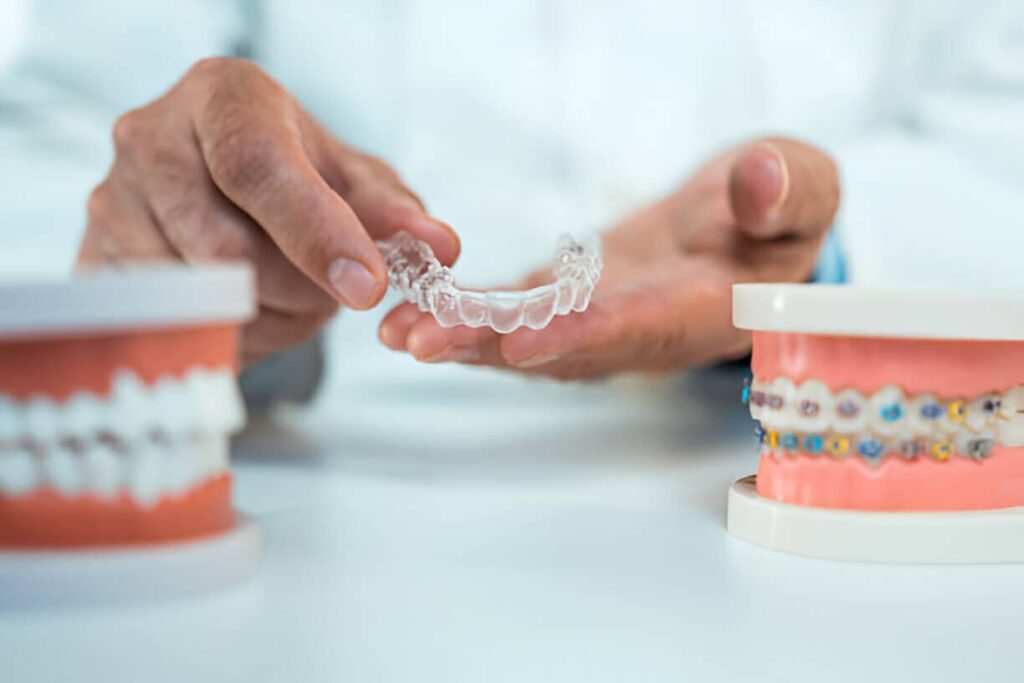A straight smile can do much more than boost your confidence; it can improve your oral health. If you have teeth that are crooked, crowded, or don’t align correctly when you bite, orthodontic treatment can help. There are two popular orthodontic treatment options today; braces and Invisalign. Both methods are effective and move teeth, but differ in some important ways that relate to your choice.
If you are thinking about considering orthodontics in West Kelowna, you will find it useful to understand how braces and Invisalign each work, as well as which method would be best suited for your lifestyle, dental needs and budget.
What Are Braces?
Braces have been used for decades to straighten teeth, working by using small metal or ceramic brackets that are glued to each tooth. A wire connects each of these brackets and methodically moves your teeth into position. Brackets are on your teeth 24/7 and are adjusted every 4 to 8 weeks.
Braces are strong and bring teeth into position and align teeth for more complex dental problems, including major tooth crowding, gaps, or bite problems. However, they are very visible, sometimes uncomfortable, after an adjustment, and you’ll need to make some changes to your diet and avoid sticky candy or corn on the cob. Because of the wires and brackets, you must be extra diligent in cleaning your teeth.
What Is Invisalign?
Invisalign is a modern alternative to braces. It uses a series of clear, removable plastic aligners that fit snugly over your teeth. Every 1 to 2 weeks, you switch to a new set of aligners, gradually shifting your teeth into place.
One of the biggest benefits of Invisalign is that the aligners are nearly invisible. You can remove them when you eat, drink, brush, and floss. This makes it easier to maintain your usual routine. However, for Invisalign to work properly, you must wear the aligners for 20 to 22 hours per day. Invisalign works well for mild to moderate alignment issues, but it may not be the best option for severe bite problems or complex tooth movements. A dentist near you can help you decide if Invisalign is right for your smile.
How Do I Tell If I Need Braces or Invisalign?
Your choice will depend on your dental needs and how committed you are to following the treatment plan. Braces are a great choice if you have serious alignment issues or trouble remembering to wear removable aligners. Invisalign might be a better option if you’re looking for something more discreet and your dental issues are mild to moderate.
Your dentist will check the position of your teeth, your bite, and your oral health before suggesting a treatment plan.
Can You Choose If You Want Invisalign or Braces?
Yes, in many cases, you can decide which option works best for you. Your dentist will guide you based on your dental condition, but your preferences also matter. Think about your lifestyle, comfort, how visible you want your treatment to be, and how much effort you’re willing to put into caring for your teeth during treatment.
Some people prefer braces because they don’t require the discipline of removing and replacing aligners. Others choose Invisalign for its flexibility and invisible appearance.
Start Your Smile Journey with Westbank Dental & Implant Center
Deciding between braces and Invisalign doesn’t have to be confusing. Whether you’re looking to fix small alignment issues or need a more involved correction, the team at Westbank Dental & Implant Center is here to help.
Ready to take the next step? Book a consultation today to explore your options and begin your journey toward a healthier, straighter smile. Your perfect smile starts with a simple visit. Don’t wait! Schedule your appointment with Westbank Dental & Implant Center now and get ready to smile with confidence!

